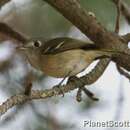en
names in breadcrumbs


Hutton's vireo (Vireo huttoni) is a small songbird. It is approximately 5 inches (12–13 cm) in length, dull olive-gray above and below. It has a faint white eye ring and faint white wing bars. It closely resembles a ruby-crowned kinglet, but has a thicker bill, blue-gray legs, and is slightly larger in size. Its most common song is a repeated chu-wee, or a chew, but will have other variations. Its call is a mewing chatter.
It is found from southern British Columbia in Canada to central Guatemala in Central America. Recent DNA studies suggest this species may be split into at least 2 different species, with coastal Pacific birds showing enough genetic variation when compared to interior ones.
This vireo makes a hanging cup nest suspended from a fork of a tree. The female lays 3–4 eggs. The eggs are mostly white in color, with scattered brown spotting. It prefers deciduous-mixed forests, and is particularly fond of live oak. It feeds by gleaning insects as it deliberately moves through the forest canopy.
Birds are mostly resident year-round, but there may be some altitudinal and short distance migration. Hutton's vireo may join a mixed-species flock for the winter.
The bird's name commemorates the US surveyor William Rich Hutton.[2]
Hutton's vireo (Vireo huttoni) is a small songbird. It is approximately 5 inches (12–13 cm) in length, dull olive-gray above and below. It has a faint white eye ring and faint white wing bars. It closely resembles a ruby-crowned kinglet, but has a thicker bill, blue-gray legs, and is slightly larger in size. Its most common song is a repeated chu-wee, or a chew, but will have other variations. Its call is a mewing chatter.
It is found from southern British Columbia in Canada to central Guatemala in Central America. Recent DNA studies suggest this species may be split into at least 2 different species, with coastal Pacific birds showing enough genetic variation when compared to interior ones.
This vireo makes a hanging cup nest suspended from a fork of a tree. The female lays 3–4 eggs. The eggs are mostly white in color, with scattered brown spotting. It prefers deciduous-mixed forests, and is particularly fond of live oak. It feeds by gleaning insects as it deliberately moves through the forest canopy.
Birds are mostly resident year-round, but there may be some altitudinal and short distance migration. Hutton's vireo may join a mixed-species flock for the winter.
The bird's name commemorates the US surveyor William Rich Hutton.